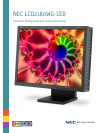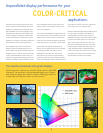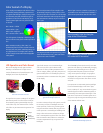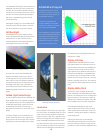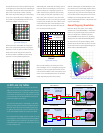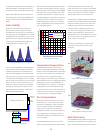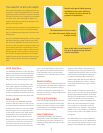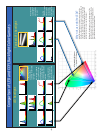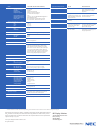
10 Bit Interface
The LCD2180WG-LED features a video input that
supports 10 bit digital video using a single Dual-
Link DVI cable. This means that the full capabili-
ties of the 10 bit display can be realized without
being restricted to an 8 bit video input source.
While there are not currently any mainstream
video graphics adapters or operating systems
that support full 10 bit video processing and
output, the LCD2180WG-LED display is designed
for future compatibility and leads the way to the
time when 10 bit video will become mainstream.
Advanced FRC
The LCD panel on the LCD2180WG-LED display
achieves an effective output of 10 bits per color
by using an advanced Frame Rate Control dither-
ing algorithm. As with other 10 bit color displays,
the panel supports the most significant 8 bits
of video directly and the 2 least significant bits
are displayed by using a time-domain dither-
ing method known as Frame Rate Control, in
which pixels are changed in intensity according
to the level of the 2 lower bits at a rate that is
faster than the human eye can perceive. This
time-domain dithering is further enhanced by
using a special spatial algorithm that ensures
that adjacent pixels operate at different parts
of the Frame Rate Control cycle thus making
any artifacts of the Frame Rate Control process
imperceptible.
Passive Cooling
The power LEDs used in the display dissipate heat
during operation. The display uses a combination
of a large heat sink with convection cooling to
maintain the temperature of the display. This
eliminates the need for a cooling fan which would
introduce acoustic noise.
Mercury Free Design
Unlike CCFL backlight based displays, which con-
tain mercury vapor inside the florescent lamps,
thereby restricting the usage in certain operat-
ing environments, the LCD2180WG-LED display is
mercury free and RoHS compliant.
Color Calibration
The optional SpectraView
II
color calibration
package offers further enhancements by provid-
ing a wide array of functions and features for
calibrating, profiling and monitoring the status
of the display.
The SpectraView
II
software communicates with
the display directly using Display Data Channel
- Command Interface (DDC/CI), which is a two-way
communications link between the video graph-
ics adapter and display monitor that uses the
standard video signal cable. No extra cables are
necessary. All adjustments to monitor settings
are performed automatically using this commu-
nications link.
The LCD2180WG-LED features three internal 10
bit LUTs (one for each color) that are programmed
directly by SpectraView
II
via DDC/CI. These tables
allow very precise adjustments to be made to the
display’s Tone Response Curve without signifi-
cantly reducing the number of displayable colors.
Because all of the Tone Response Curve adjust-
ments are done in a 10 bit domain within the
display itself, the host computer’s video graphics
adapter’s LUTs are set to linear, thus maximizing
the use of the 16+ million color palette in an 8 bit
color system.
The software allows custom target calibrations
to be created with preset or user definable white
points, intensity levels and tone response curves
(gamma curves). Advanced tone response curves
The need for 10 bit color depth
The increased color gamut of the display means that the
overall color “volume” of displayable colors has increased
significantly. However the number of discrete color levels
from the host system has not changed from the standard
16+ million colors, unless video graphics adapters, ap-
plications and Operating Systems, that all support 10 bit
graphic processing are used.
This means that there are fewer discrete displayable color
levels per unit of color volume on a wide gamut display
than on a standard gamut display, which can lead to color
banding issues.
Due to the LCD2180WG-LED being able to use the red, green
and blue LED intensity to adjust the white point, rather
than sacrificing displayable color levels using look-up-ta-
bles, this loss does not present a significant problem. How-
ever the display will be able to take advantage of future
generations of video graphics adapters, applications and
Operating Systems that are capable of outputting video
with the full 10 bit digital video depth that the display is
capable of accepting, thus providing an end-to-end color
palette of up to more than 1,000,000,000 displayable
colors.
Normal color gamut display showing
available discrete colors with 8 bit
video (number of colors reduced for
purposes of explanation)
The same number of discrete colors
on a wide color gamut display occupy
a larger volume.
When 10 bit video is used instead of 8
bit, up to 64 times as many discrete
colors are available.
7



